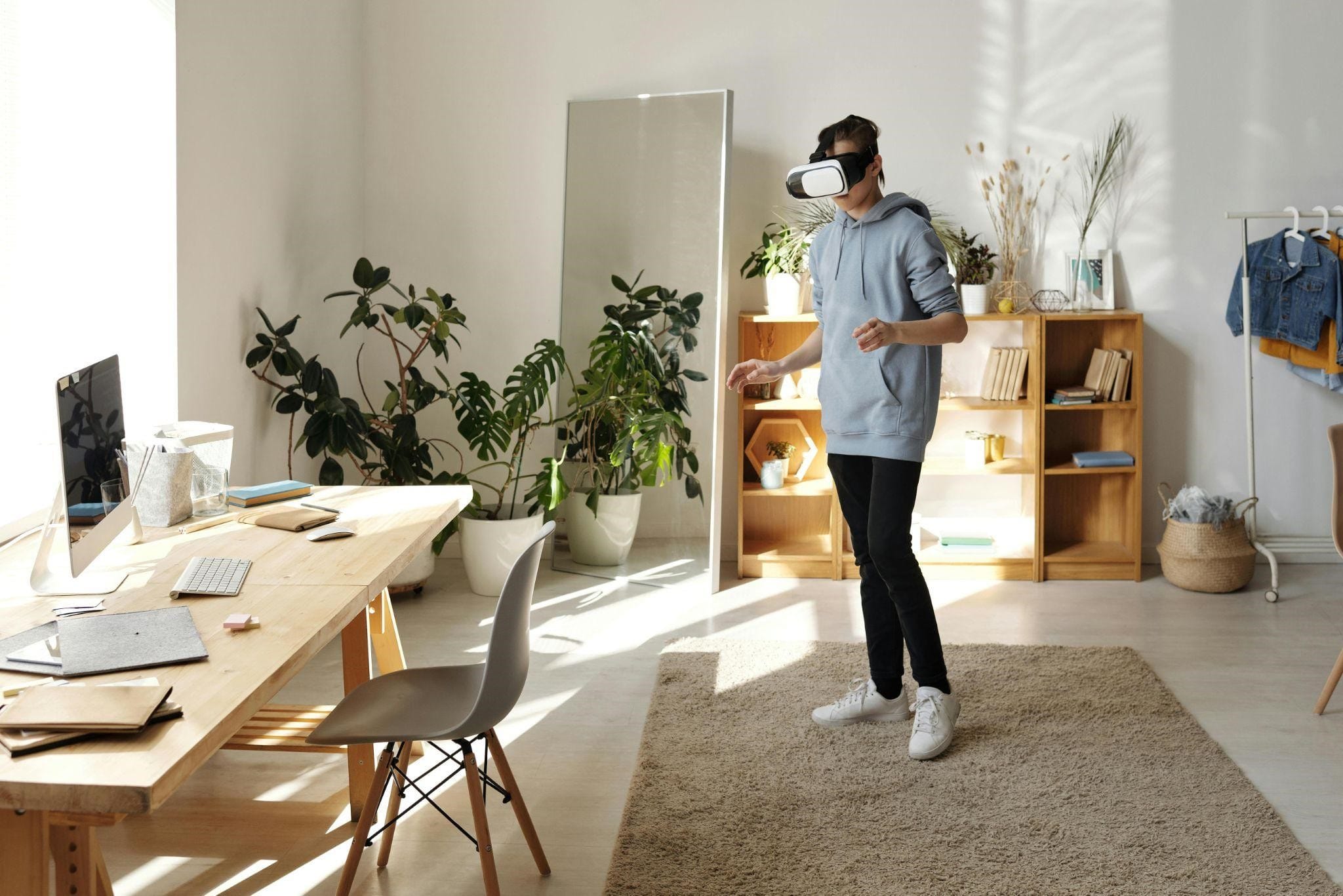Extended Reality (XR) in Business: How It's Transforming Industries in 2026
Extended Reality (XR) has evolved from an experimental technology into a business essential. With major players like Meta, Apple, and Microsoft investing billions into high-quality XR headsets and enterprise-grade tools, the ecosystem is maturing faster than ever.
Businesses are already seeing tangible results. Studies show that the presence of Extended Reality (XR) in business can reduce operational costs and boost productivity by 10–20% by optimizing workflows and improving training efficiency.
From immersive training and design visualization to remote collaboration, virtual marketing, and customer engagement, XR is bridging the gap between digital and physical worlds. It enables teams to work smarter, brands to connect more deeply, and industries to innovate faster.
What is Extended Reality (XR)?

Extended Reality (XR) is the umbrella term for Augmented Reality (AR), Virtual Reality (VR), and Mixed Reality (MR); it encompasses all immersive technologies that expand how we experience and interact with the world.
Augmented Reality (AR): AR enhances the physical world by adding digital overlays to it. AR creates unique, engaging campaigns for print media, product packaging, and out-of-home (OOH) advertising. Here's an example of AR in action:
IKEA Place allows users to visualize furniture in their own rooms through smartphone AR. This empowers customers to see whether an item fits or suits their space.
Virtual Reality (VR): VR can help create fully immersive environments. It replaces the physical environment with a computer-generated setting. Through this tech, users can easily explore branded worlds, interactive storytelling, and virtual experiences. Here's an example of VR in action:
Walmart uses VR to simulate real store environments for employee training (customer service, emergencies, store layout) so staff can gain experience in a safe, controlled space.
Similarly, virtual showrooms of Audi and Volvo offer VR test drives or virtual configurations of cars to help potential buyers explore interiors and drive simulators.
Mixed Reality (MR): MR combines elements of both VR and AR to blend digital and real-world environments in real time. MR allows users to interact with digital content while remaining aware of their physical surroundings. Here's a great example of MR in action:
- The LloydXFlam MR Campaign transformed print ads into 3D experiences. Users could scan a QR code to explore product features in their real surroundings with their phones. Users did not have to download an app or invest in expensive headsets to experience its unique products.
How Industries Shape and Leverage Extended Reality
Across sectors, XR is redefining how organizations design, train, and engage. By merging digital content with real-world environments, businesses are unlocking new levels of efficiency, creativity, and customer experience. Here are some industries that have leveraged XR to boost productivity:
Manufacturing
Manufacturing brands are using XR to streamline operations and improve safety. AR helps guide assembly and quality checks, while VR enables training for high-risk tasks. For example, Boeing uses AR to assist technicians with wiring tasks, and Ford employs VR to test vehicle designs before production.
Healthcare
XR allows medical professionals to train, plan, and treat more effectively. Surgeons can practice in VR simulations, and AR overlays improve precision during procedures. Osso VR provides realistic surgical training, while AccuVein projects vein maps onto patients for accurate IV insertions.
Retail
Retailers and brands in retail leverage XR to create interactive shopping experiences that drive engagement and sales. AR lets customers try products virtually, and VR enables immersive store tours. Sephora Virtual Artist lets shoppers try on virtual makeup, and IKEA Place lets shoppers see furniture in their own homes.
Real Estate
XR enables clients to explore and personalize properties remotely. VR tours showcase homes, and MR allows design changes to be visualized in real time. Matterport provides 3D VR property tours, and LIV Realty uses MR walkthroughs to let clients test different layouts before construction.
Education
XR transforms learning by making abstract concepts tangible. Students can explore historical sites, complex scientific phenomena, or engineering structures in 3D. Google Expeditions offers virtual field trips, and zSpace provides interactive AR/VR lessons in STEM subjects.
Travel
Travel brands are using XR to offer immersive previews of destinations and accommodations, enhancing customer confidence before booking. For instance, Marriott provides virtual reality hotel tours, allowing potential guests to explore rooms and amenities remotely, aiding in their decision-making process.
Extended Reality Case Studies: Real-World Business Impact

Extended Reality (XR) is transforming industries by enhancing operational efficiency, customer engagement, and innovation. Here are some notable examples:
XReality Group: An Australian startup, XReality Group, has expanded its presence in the USA by providing virtual reality (VR) training systems to police and military organizations. Their Operator XR system allows users to train in various high-risk scenarios, such as plane hostage rescues and active shooter emergencies, in a controlled VR environment. It is a great use case of XR training solutions.
Marriott International: Marriott has implemented virtual reality hotel tours, enabling potential guests to explore rooms and amenities remotely. This immersive experience has enhanced customer confidence and decision-making, leading to increased bookings and customer satisfaction.
TeamViewer: TeamViewer's Frontline platform utilizes augmented reality (AR) to provide real-time information and hands-free guidance in logistics, manufacturing, and healthcare sectors. This technology has improved workflows, reduced errors, and streamlined onboarding processes.
Top 3 Domains Where XR Progressed in 2025
Enterprise Training & Simulation: Companies are increasingly adopting VR and MR for high-stakes training scenarios, from factory safety to surgical procedures.
Retail & Marketing: AR-driven try-ons, virtual showrooms, and MR campaigns are boosting engagement, conversion, and brand loyalty.
Design, Prototyping & Collaboration: XR allows teams to visualize complex products, test workflows, and collaborate remotely, cutting development cycles and costs.
4 Areas Where Extended Reality Can Benefit Businesses
Operational Efficiency & Cost Savings
XR can streamline operations and reduce errors by simulating processes before execution. Examples include AR-guided maintenance in manufacturing and VR-driven planning in construction, leading to measurable cost reductions.
Employee Training & Skills Development
VR and MR provide safe, repeatable environments for training employees in high-risk or complex tasks. Companies like Walmart and Boeing have seen improved performance, faster onboarding, and higher retention through immersive learning.
Customer Engagement, Marketing, and Sales
XR transforms how brands interact with customers. AR virtual try-ons, VR showrooms, and MR campaigns, such as Lloyd's interactive AC promotion, to create memorable experiences, increasing conversion and loyalty.
Innovation & Competitive Differentiation
By adopting XR early, businesses can differentiate themselves in crowded markets. XR enables rapid prototyping, immersive presentations, and novel customer experiences that competitors without XR cannot match, establishing a clear innovation advantage.
Addressing the Challenges of Implementing Extended Reality in Business
Here are some common XR implementation challenges that limit its use across industries:
High Hardware Costs: Investing in XR headsets, AR devices, and supporting infrastructure can be expensive, especially for small and medium-sized businesses.
Integration with Legacy Systems: Incorporating XR into existing workflows and IT systems can be complex and may require custom solutions.
Content Creation Complexity: Developing high-quality XR experiences demands specialized skills, tools, and time, which can be a barrier for many organizations.
User Training and Adoption: Employees may need guidance and training to use XR tools, which can slow down adoption effectively.
Security and Data Privacy: XR solutions often collect sensitive data, making secure handling and compliance critical.
The Impact of Extended Reality (XR) Solutions on Business Transformation
XR is transforming how businesses operate, innovate, and engage customers. By creating immersive marketing experiences, XR improves operational efficiency, enhances training outcomes, drives customer engagement, and accelerates product development.
The XR business impact in 2025 is profound; organizations that have adopted XR have seen huge benefits in productivity, cost savings, and overall competitiveness.
Immersive Training and Education
XR allows employees and learners to practice skills in realistic, risk-free environments. VR simulations, AR overlays, and MR interactions provide hands-on experience without real-world consequences.
Siemens uses VR to train factory workers on complex machinery, reducing accidents and increasing knowledge retention.
Strivr provides immersive VR training for corporate employees, improving engagement and long-term retention rates.
Enhanced Customer Experience
XR enables brands to deliver interactive, personalized, and memorable experiences to boost engagement, loyalty, and conversion.
L'Oreal AR Virtual Try-On allows customers to try makeup digitally before purchasing, improving confidence and sales.
Marriott VR Tours let guests explore hotel rooms and amenities remotely, aiding booking decisions.
Remote Collaboration and Productivity
XR supports virtual meetings, team collaboration, and real-time problem-solving, reducing the need for physical presence and travel.
Spatial allows teams to collaborate in shared virtual spaces, manipulating 3D models and workflows together.
Microsoft Mesh enables mixed-reality collaboration for distributed teams, improving alignment and productivity.
Product Design, Prototyping, and Visualization
XR accelerates product development by enabling virtual prototyping and 3D visualization, reducing the cost and time of physical iterations.
Ford uses VR to test vehicle designs before manufacturing.
Boeing uses AR and MR to visualize aircraft components during the design and assembly process.
Data Visualization and Decision-Making
XR helps transform complex data into interactive 3D visualizations, making insights easier to understand and act upon.
GE Healthcare uses AR dashboards to visualize medical device performance and operational data for faster decision-making.
Siemens employs MR to analyze production data and optimize manufacturing workflows in real time.
Conclusion: The Future of Extended Reality (XR) in Business
Gone are the days when XR was viewed as a futuristic concept in movies and TV shows. Today, Extended Reality (XR) in business is a strategic necessity. As XR technology becomes more accessible, affordable, and scalable, organizations across sectors will increasingly integrate XR into their operations. From training and collaboration to customer engagement and product innovation, XR is set to redefine how businesses operate, compete, and grow in the years ahead.
Flam: Extended Reality Solutions for Brands and Advertisers
Flam is revolutionizing the way brands connect with audiences by turning traditional media into immersive, app-free XR experiences. Consumers can instantly interact with content, making every campaign more engaging and memorable.
As an AI-powered mixed reality publishing platform, it provides real-time analytics and performance insights to help brands to optimize campaigns and measure impact with precision. Flam's intuitive tools democratize XR, enabling businesses of all sizes to create high-impact, interactive campaigns without technical expertise.
Trusted by leading brands like Tanishq, KFC, Samsung, Britannia, and Godrej, Flam is redefining advertising and marketing, making XR a scalable, versatile, and powerful tool for the modern brand.